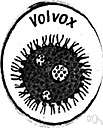volvox
Also found in: Thesaurus, Medical, Acronyms, Encyclopedia, Wikipedia.
vol·vox
(vŏl′vŏks′, vôl′-)n.
Any of various one-celled flagellate freshwater green algae of the genus Volvox that form hollow mucilaginous spherical colonies of several hundred cells.
American Heritage® Dictionary of the English Language, Fifth Edition. Copyright © 2016 by Houghton Mifflin Harcourt Publishing Company. Published by Houghton Mifflin Harcourt Publishing Company. All rights reserved.
volvox
(ˈvɒlvɒks)n
(Microbiology) any freshwater flagellate protozoan of the genus Volvox, occurring in colonies in the form of hollow multicellular spheres
[C18: from New Latin, from Latin volvere to roll]
Collins English Dictionary – Complete and Unabridged, 12th Edition 2014 © HarperCollins Publishers 1991, 1994, 1998, 2000, 2003, 2006, 2007, 2009, 2011, 2014
vol•vox
(ˈvɒl vɒks)n.
any colonial freshwater green algae of the genus Volvox, forming a hollow sphere of flagellated cells.
[1790–1800; < New Latin, = Latin volv(ere) to turn, roll + -ōx (as in ferōx)]
Random House Kernerman Webster's College Dictionary, © 2010 K Dictionaries Ltd. Copyright 2005, 1997, 1991 by Random House, Inc. All rights reserved.
ThesaurusAntonymsRelated WordsSynonymsLegend:
Switch to new thesaurus
| Noun | 1. |  Volvox - type genus of the Volvocaceae; minute pale green flagellates occurring in tiny spherical colonies; minute flagella rotate the colony about an axis Volvox - type genus of the Volvocaceae; minute pale green flagellates occurring in tiny spherical colonies; minute flagella rotate the colony about an axisprotoctist genus - any genus of Protoctista family Volvocaceae, Volvocaceae - unicellular or colonial biflagellate free-swimming flagellates |
Based on WordNet 3.0, Farlex clipart collection. © 2003-2012 Princeton University, Farlex Inc.